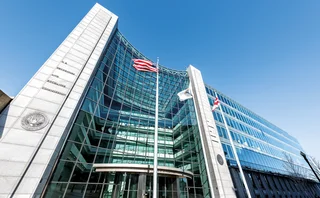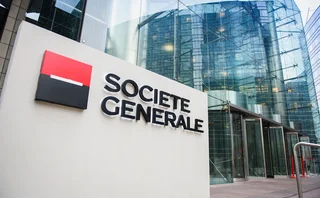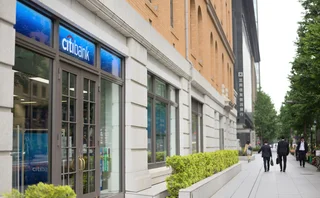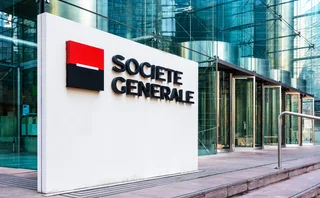
Merged offerings
The merger of Crédit Agricole and Crédit Lyonnais has created a major force in the French structured products market. But Bertrand Penverne, head of structured products for France at Crédit Agricole Asset Management, is not about to rest on his laurels, as Patrick Fletcher discovers

The merger of two of France’s best known high street banks, Crédit Agricole and Crédit Lyonnais, in 2003, formed a retail banking giant. With the assimilation of CLAM, Crédit Lyonnais’s asset management business, Crédit Agricole Asset Management (CAAM) became one of the largest in the country with €273 billion in asset under management.
“Overnight, we doubled the number of products we deal with,” says Bertrand Penverne, Paris-based head of structured products for France at CAAM. The two departments moved in together in June 2004, a year after the official announcement of the merger. “It made the job richer, as there are now different clients with different needs,” he says.
Penverne is nonetheless keen to stress that he doesn’t aim to structure products in different ways for individual banks. “That’s not the idea. Clients sometimes have similar needs, and if that is the case you will probably end up with similar answers. But given the sensitivity of our distribution, they won’t necessarily prefer the same answer,” he says.
Strategic differences
The top retail distributors all pursue different strategies. Rival Caisse d’Epargne, for instance, will each month launch products with similar structures. “Then they get a new idea, and will do that for another six products,” says Penverne, adding that it is a much more intensive method of distribution. CAAM’s distributors, on the other hand, take a different route. “They usually have an offer period of around three months, excluding the summer when clients are difficult to reach. This means there are two or three big campaigns a year, depending on their schedules. And the distribution schedule has to integrate the constraints imposed by the large scale of different products offered within the network,” he says.
Penverne says that a large branch network is essential to maximising product sales. A fairly obvious statement, one might think, until one considers the size of the French branch networks compared to the more fragmented UK market. HSBC in the UK has 1,576 branches; Lloyds TSB has 2,200 and Barclays – even including its Woolwich subsidiary – tops out at 2,461. By contrast, Crédit Agricole, which has the largest branch network in France, controls over 9,100 outlets. The network’s retail offering is based on its 2,629 local banks, which run 7,260 branches. These in turn are run by 43 regional banks. Crédit Lyonnais rounds the figure out with its 1,850 branches.
Marketing within the Crédit Agricole networks is operated by the individual networks themselves, but, unlike some of the other players in the market, they don’t tend to spend large amounts of money on lavish campaigns. “We always have leaflets, posters and so on, but not on the scale of some other banks,” Penverne says. Marketing is becoming more of an issue in France, however, with BNP Paribas and Caisse d’Epargne embarking on big marketing drives.
Growth in the banking sector is usually a result of poaching new customers from competitors. And Penverne believes that structured products can be a good marketing tool in themselves. “When we want to attract new clients from other banks, it can be a product that attracts them. And this is where the growth lies,” he says.
Indexes in favour
Like La Poste, Penverne prefers to use indexes rather than baskets of stocks or funds as the underlying. “In the retail market , no mutual fund is as well known as the CAC 40 or other famous indexes,” he says. “Using an index means the product is easier to explain to a customer and the market is more liquid.” The majority of Crédit Agricole’s products are linked to a basket of indexes, including Nikkei 225, EuroStoxx 50 and S&P 500. The FTSEurofirst80 has also started to make an appearance, as well as a product linked to the FTSE4Good index.
However, Penverne, like most retail product issuers, does not believe that this list of underlying indexes is going to get bigger: “I’m not convinced retail investors want to be on the Nasdaq, for instance,” he says.
Share baskets, so popular in 2002 and 2003, could well be disappear from product offerings. Caisse d’Epargne, in particular, showed a
preference for them in the past with its multi-tranched Cappuccino, Doubl’O’Monde, Snowball and Cordillere products. However, since the final tranche of Cappuccino – its ninth – was issued in March 2004, even Caisse d’Epargne has only used funds and indexes as underlyings.
Penverne is relatively new to the world of structured products. He joined Crédit Lyonnais Asset Management in 2001, following a spell working on the sell-side in Japan, trading options on Japanese government bonds, among other roles. “Intellectually speaking, the biggest challenge in the financial world at that time was in structured products, as the market evolved from plain vanilla to more exotic,” he says.
Entering the market as the dotcom crash was in full swing, he has become familiar with the argument that says structured products are merely a fashion borne out of market behaviour. But he refutes this. “[Structured products] were made possible because the liquidity on some sophisticated instruments rose. When equity markets fell, everybody wanted a protected or guaranteed product, even if it didn’t match their true risk appetite,” he says. Now, Penverne believes that market forecasts which point to slow and steady growth in the near future are diffusing the clientele. “This feeling is removing that part of the clientele who bought products during the slump. But at the same time, some people discovered that these are the types of investments that suit them perfectly,” he says.
Interest rates
Although the behaviour of the stock market plays a big role in demand, Penverne says that on the sell-side the key factor is the movement of interest rates. “A product is only ‘good’ when compared to the market conditions. If the interest rate is 2%, then making 6% is exceptional. But given people’s expectations, the perception could be that it’s not that good,” he says. He adds that if interest rates fall any further it will be almost impossible to make short-dated products which are 100% capital guaranteed.
“There could be a shift in the market, forcing people to accept some risk to their capital if they want good performance. Even a 95% or 90% guarantee would be a big change,” he says, pointing out that moving to a guarantee of 95% on a five-year product equates to a 1% rise in interest rates. “It would make a huge difference to the kind of product you can structure. I don’t know if the appetite for this will rise, but I hope so,” he adds.
Interest rates in the eurozone are currently hovering at 2%, a level confirmed at February’s European Central Bank (ECB) monetary policy meeting, when the Governing Council left rates on hold. The decision facing the Council was whether to leave them on hold or raise them, not to cut them. “Upside risks to price stability remain,” according to the ECB’s monthly bulletin, which added that low, steady growth would continue into 2005, thus easing downward pressure on rates even more (see graph). With interest rate risk skewed to the upside, product issuers such as CAAM may be able to offer more attractive payoffs in 2005.
Only users who have a paid subscription or are part of a corporate subscription are able to print or copy content.
To access these options, along with all other subscription benefits, please contact info@risk.net or view our subscription options here: http://subscriptions.risk.net/subscribe
You are currently unable to print this content. Please contact info@risk.net to find out more.
You are currently unable to copy this content. Please contact info@risk.net to find out more.
Copyright Infopro Digital Limited. All rights reserved.
As outlined in our terms and conditions, https://www.infopro-digital.com/terms-and-conditions/subscriptions/ (point 2.4), printing is limited to a single copy.
If you would like to purchase additional rights please email info@risk.net
Copyright Infopro Digital Limited. All rights reserved.
You may share this content using our article tools. As outlined in our terms and conditions, https://www.infopro-digital.com/terms-and-conditions/subscriptions/ (clause 2.4), an Authorised User may only make one copy of the materials for their own personal use. You must also comply with the restrictions in clause 2.5.
If you would like to purchase additional rights please email info@risk.net
More on People
People: All shook up at the SEC, Krens succeeds Litvack at Isda, and more
Latest job changes across the industry
Girolami to leave LCH for NatWest
Clearing house CEO named CIB head for UK lender
People: SocGen and Nomura spot slew of FX hires, RepoClear gets new head, and more
Latest job changes across the industry
People: All fall in at Citi, TD turbulence, and more
Latest job changes across the industry
Asia moves: senior hires at Citi, BNP Paribas, and more
Latest job news from across the industry
People: Masters moves into FNZ, Two Sigma founders step back, and more
Latest job changes across the industry
Cardano’s Max Verheijen moves to BasisPoint
Verheijen spent 24 years at the Dutch pension advisory firm
People: SocGen’s Farah replaces Salorio, Deutsche makes credit hire, and more
Latest job changes across the industry







